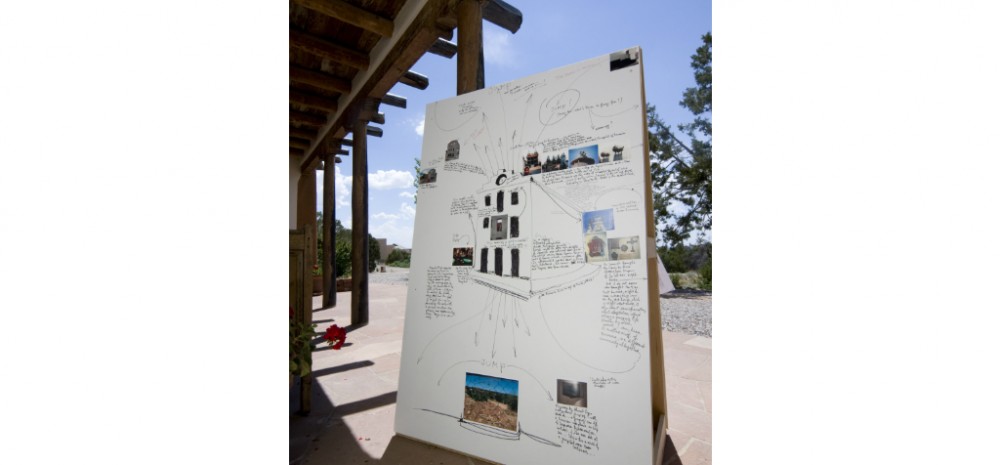Born in 1957 in Sofia, Bulgaria
Lives and works in Sofia, Bulgaria
Luchezar Boyadjiev
Off-SITE(s), 2008
There are three main objectives of this project: a) sharing my feeling of being “lucky†to be in Santa Fe by distributing part of my production budget to the local audience through random selection of names from the local telephone book; b) sharing the knowledge and experience that I have accumulated over the years about what an international art show is through training an art squad of informed visitors who will mingle with the local audience; and c) sharing the possibility to express oneself in an art show by responding to the issues raised by the same art show and by providing a relatively democratic platform to do so in a number of off-site locations.
Years ago I noticed that for me it is almost equally interesting and challenging to: a) have people in a certain city look at my works installed on the wall or in the spaces of their local museum (or in the Biennial, for instance) and b) to get to know these same people  at first by looking at them and then by talking to them  without necessarily “bombarding†their eyes with my visual works. I feel it is a bit ridiculous to have a show running for three months and the local audience does not even get a chance to spend a day with the artists in the show (artists are usually gone the day after the opening). There are artists who care about who goes to see their work or becomes an active part of their work  and I happen to be one of these artists  and then there are artists for whom that is not so important. Even Leonardo and Michelangelo occasionally got a chance to meet and talk to their audiences Plus, for sure they never got to travel as much as I do So, every once in a while I get away with talking a curator into letting me work with the local people more extensively. In this case it was not difficult as this was the initial idea of the curator.
Part of the intimate ideology of Lucky Number Seven is the idea of making works whose material existence is ephemeral and whose materials are potentially recyclable. The most valuable and important “recycling†aspect of my project in Santa Fe is the long-term “recycling†effect of my true material for the work  that is the audience, the “non-participating participantsâ€, as I call them. My intention is to activate their presence and perception as much as possible, thus the true recycling effect will be visible and effective, I hope, long after the finisage (end) of the Biennial. For me, the activation of the community through the transformation of the audience into insiders is the main aspect, and next time it might be more interesting to be a SITE Santa Fe Biennial audience member.
Luchezar’s “Art Squad†will maintain and moderate message boards, or hotspots, located around the city in other important art institutions, including the Center for Contemporary Arts, The Georgia O’Keeffe Museum, the Institute of American Indian Arts Museum, the Palace of the Governors, the Museum of Indian Arts and Culture, and the Museum of Spanish Colonial Arts. The Art Squad will include several artist and departmental interns in addition to local youth. The Art Squad is still recruiting if you know a local youth (older than 17) who may be interested, contact Juliet Myers at myers@sitesantafe.org.
In 1998 Luchezar Boyadjiev exhibited his installation Home/Town, a work that he made by collaging small photos of the interior of his apartment over large-size photos taken of the exteriors of Sofia, the city where he works and lives. Positioned within and around different locales throughout Sofia, the collages looked like billboards. As Boyadjiev explains, “I thought I was reclaiming my visual possession of the city where I grew up and which is a different city now.â€
Home/Town initiated a cycle of works by Boyadjiev that investigate the ever fluctuating process of negotiations between the local and global; between the permanency of a place and the environment that surrounds it; between living quarters that are no longer private sanctuaries, and the world of political, informational, and cultural transformations.
A keen observer and critical interpreter of the social, political, and cultural development that have occurred in his native Bulgaria, in addition to other nations undergoing the dramatic shifts instigated by globalization, Boyadjiev creates works that both respond to these changes while simultaneously challenging the physical nature of contemporary art. As with Home/Town, Boyadjiv uses the familiar imagery of an apartment only as a means to de-familiarize it, in effect, making the formerly banal place something new and exotic by shifting its context. His “re-shuffling†of images challenges our reading habits for its meanings and messages.
Boyadjiev’s photo-based installations, interventions, and performances often occur outside of the traditional institutional environment of a museum exhibition setting. His ongoing Guided Tour series (2003) examines how contemporary art produced in one urban context is perceived in another. In previous international biennials, Boyadjiev’s contribution has been as a tour guide. Part performer, teacher, historian, and ad-man, Boyadjiev gives visitors guided tours through the exhibition. In contrast to the traditional didactic materials offered to the public by the curator, Boyadjiev offers his audience a personal perspective on the works in the exhibition, often creating new links between objects, ideas, individuals, and their environment for the benefit of a single visitor. His gesture provides an alternative route to bridging issues that typically divide us as tours are a way to access the art that previously would have been inaccessible.
Iara Boubnova
